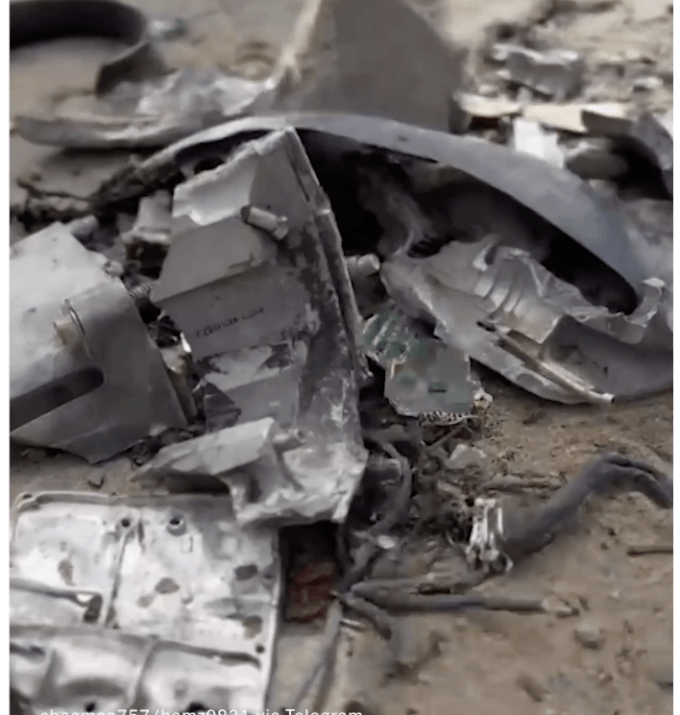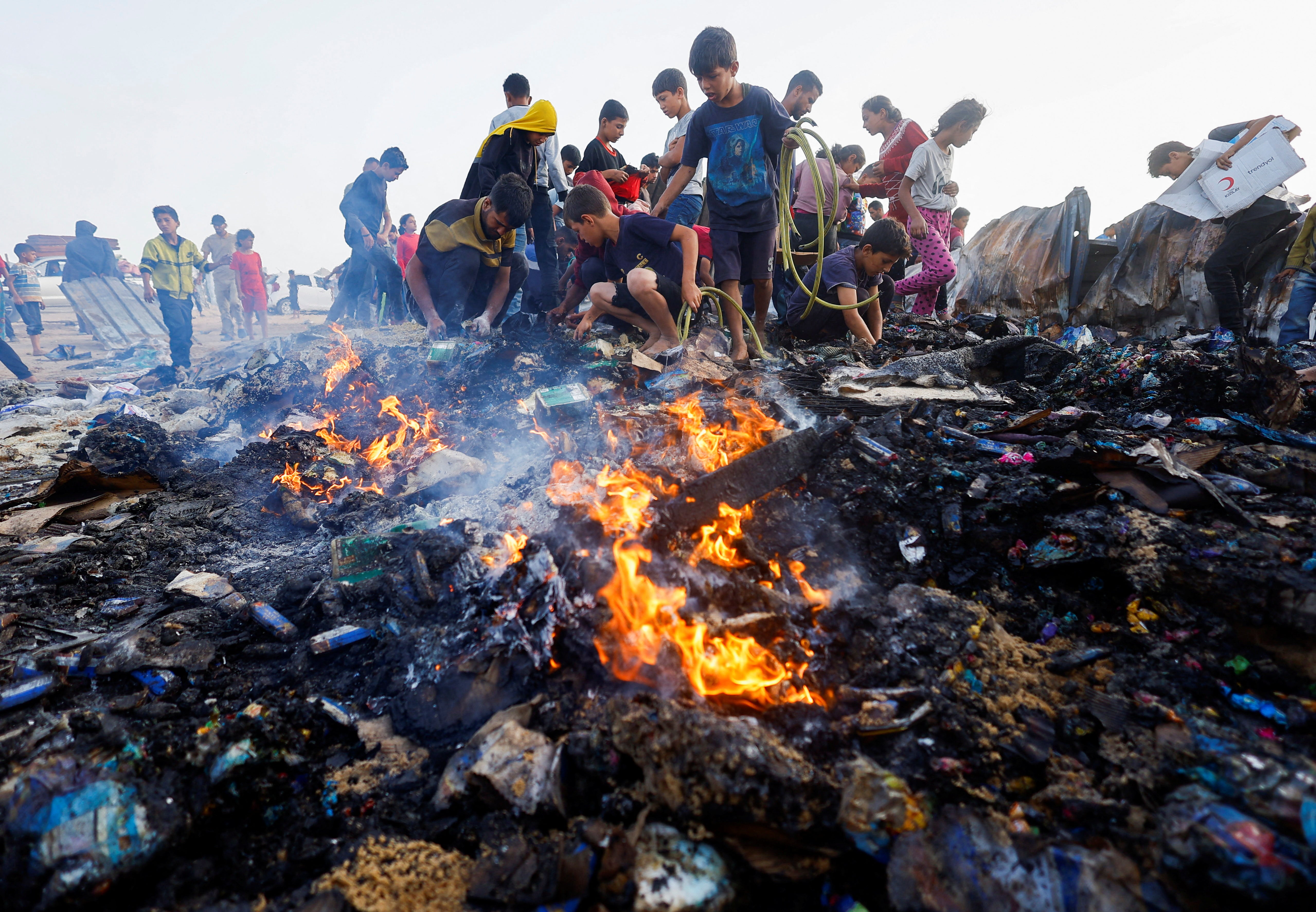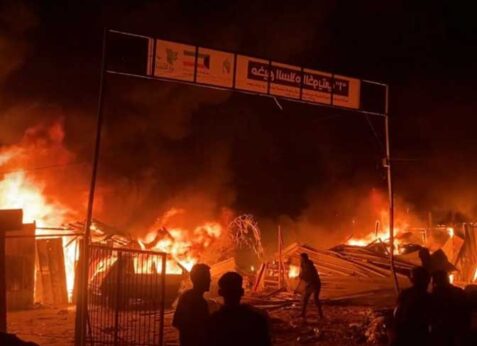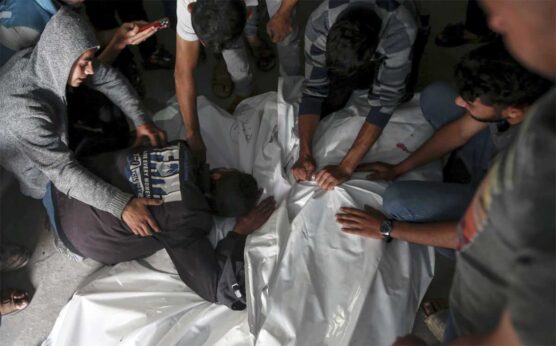Popular University for Gaza encampment at the University of Oregon demanding divestment from companies supporting Israel. Day 2, April 30, 2024. Image Credit: Ian Mohr, Flickr.
Reposted from MR Online
An earlier version of this article was published in Counterpunch, May 3, 2024.
As Israel began its genocide in Gaza, those who manage U.S. colleges and universities also commenced to issue statements of outrage at what Hamas had done. And as campus protests erupted in condemnation of the slaughter of Gazans, and especially children, and the destruction of homes and every major institution, including hospitals, these same institutions of highher learning began to disrupt these protests and bring them to an end. As a former college teacher, one who witnessed the attacks on those who protested against the War in Vietnam and who studied the repression on campuses during the McCarthy period, I became so appalled at what was being done to our brave and courageous college students that I began to write letters to the leaders of what are, in reality, academic enterprises.
University of Pittsburgh
Immediately after the October 7, 2023 attack on Israel by Hamas and other Palestinian groups, on October 10, the chancellor of the University of Pittsburgh, Joan Gabel, sent a message to the Pitt “community” decrying Hamas’s violence and offering University services to students traumatized by this. She wrote:
Another wave of darkness has emerged in the violence taking place in Israel and Gaza. These heinous acts are antithetical to our values. We are compassionate. We are givers and doers. As such, we recognize the deep impact of these events across our community. Many of us are struggling with what we have seen, including members of our university family who face the unimaginable burden of grief for fathers and sons, mothers and daughters, brothers and sisters, friends, and loved ones. For those hurting — for those grieving — we have resources available including Pitt Global, the University Counseling Center for students, and LifeSolutions for faculty and staff. We encourage all students, faculty and staff to use them. As more resources become available, we will share them.
Given her wording, she was almost certainly addressing mainly Jewish members of the “community.” In response, I sent the following email to her the same day:
Yes, the killings were terrible. But will you send another note about grieving as the Israelis bomb hospitals and kill many innocent people?
Michael D. Yates, Pitt PhD and Pitt professor emeritus.
I sent a follow-up note on December 11, when it was clear what Israel was doing:
Still waiting but not holding my breath for you to tell us (your colleagues, Pitt family, take your pick) that you are horrified, or at least a bit disturbed, by the wanton slaughter of children in Palestine, and that Pitt will help anyone traumatized by this. I suspect that you will be like every other University CEO (which is what you are) and say nothing or agree that anti-Zionism is anti-Semitism. International law will not be something you will refer to unless the culprit is an enemy of the US in the eyes of the US government.
Yours in peace,
Michael Yates, Professor Emeritus and Pitt PhD
P.S. Monthly Review Press, of which I am Director, published a book titled A Land With a People. The introduction, written by 80-year-old Rosalind Petchesky (a Jewish anti-Zionist), is worth reading. If your flack catchers, by some rare chance, let you see this, read it, and I am certain you will learn a great deal.
Again, no response was forthcoming. To date, there is a Palestinian solidarity encampment at the University, but the university has not attempted to have it dismantled.
Hobart and William Smith College (HWS)
On April 9, 2024, HWS Professor Jodi Dean wrote an essay titled, “Palestine Speaks for Everyone,” which was published on the Verso Press Blog. It is a moving piece, and it begins with this paragraph:
The images from October 7 of paragliders evading Israeli air defenses were for many of us exhilarating. Here were moments of freedom, that defeated Zionist expectations of submission to occupation and siege. In them, we witnessed seemingly impossible acts of bravery and defiance in the face of the certain knowledge of the devastation that would follow (that Israel practices asymmetric warfare and responds with disproportionate force is no secret). Who could not feel energized seeing oppressed people bulldozing the fences enclosing them, taking to the skies in escape, and flying freely through the air? The shattering of the collective sense of the possible made it seem as if anyone could be free, as if imperialism, occupation, and oppression can and will be overthrown. As the Palestinian militant Leila Khaled wrote of a successful hijacking in her memoir, My People Shall Live, “it seemed the more spectacular the action the better the morale of our people.” Such actions puncture expectations and create a new sense of possibility, liberating people from hopelessness and despair.
The president of Dean’s college, Mark D. Gearan, took great offense to her article. Here is the opening paragraph of his letter to the HWS “community,” sent on April 13, 2024:
Earlier this week, Professor of Politics Jodi Dean wrote a piece for Verso on the war in Israel and Gaza. She spoke about feeling exhilarated and energized by the paragliders on October 7, an event that has led to so much brutality against civilians in Israel and Gaza. Not only am I in complete disagreement with Professor Dean, I find her comments repugnant, condemn them unequivocally, and want to make clear that these are her personal views and not those of our institution.
He then suspended Dean from her teaching duties. His letter and actions offended me, and I sent him this message:
Dear President Gearan,
I read your letter about Professor Jodi Dean’s essay, ‘Palestine Speaks for Everyone,’ which was posted at versobooks.com. I found your letter to be an excellent example of a false commitment to academic freedom and free speech. Taking Professor Dean out of her classroom is outrageous. Her essay speaks to a truth that cowards like you will never face. Israel is an occupying colonial power, with no right under any international law to do what it has done since the Nakba in 1948. It has violated untold UN resolutions, and it has murdered untold numbers of people with abandon. What it has done since Oct. 7 has shocked most of the world, but apparently not you. Hamas and the other Palestinian resistance groups have every right under international law to resist Israel’s brutal and illegal occupation with violence, and Israel has no right to defend its colonial regime in Palestine. This is all not to mention that Israel’s current leadership, following it the footsteps of some of its founding fathers, are open fascists. What your letter does is whitewash this past and assert a sickening superior morality under the pretense that you are opposed to all violence. Please, spare us your tears. And your self-righteousness. Your students might be afraid and troubled!! Of what, pray tell. It is the people in Gaza who are afraid, because they are being killed by the tens of thousands. And if you have been following the news outside of the cowardly mainstream US Press, you would now know that most of the most outrageous acts Israel claimed Hamas and the other groups perpetrated on Oct. 7 have been shown not to have happened. The Nazis would have been proud of Netanyahu and company for their skill in lying and their willingness to murder women and children. Just as the US would not even take orphaned Jewish children into the United States during the late 1930s, because they might someday become Bolsheviks, so too the Israelis can’t have Palestinian kids grow up t be “terrorists.” or mothers giving birth to them.
You must put Professor Dean back in the classroom. I doubt you will, perhaps in fear that you will be called before Congress and declared an antisemite. Or more likely because you are simply not a very good human being.
Yours,
Michael D. Yates, Professor Emeritus, University of Pittsburgh-Johnstown
Illinois State University
Since just after October 7, Joe Scarborough, host of MSNBC’s popular “Morning Joe” program, has been railing against the campus protests. He typically refers to students (presumably privileged) at elite (as in Ivy League) colleges. However, the campus encampments that have been growing in number by the day, have been set up in many colleges and universities that are certainly not elite. One such college is Illinois State University in Normal, Illinois. I have had correspondence with a teacher there, one whose students are by no means elite. When the president of the university, Aondover Tarhule, began threatening the protesters with punitive actions, the organizers asked people to write to him. I wrote this letter on April 30, 2024:
Dear President Tarhule,
Students around the United States are courageously protesting the open genocide being committed by the Israeli government in Gaza. That it is a genocide is widely known, and members of the Israeli state openly admit it, even declaring themselves to be fascists. Now, your students are protesting. And what does your administration do? Like many other institutions of higher learning, you threaten them with suspensions and police violence. Your duty is to protect your students. Colleges claim to be in favor of critical thinking and socially responsible actions. Yet, as soon as they take you at your word, they see that it is all a mirage.
I was a college professor for 45 years. I saw the protests against the war in Vietnam and the way that college administrators dealt with them. I know about how your predecessors condemned and blacklisted professors during the McCarthy period. Today, the world is watching. Your students are watching. What lessons will they take from your actions? The answer is up to you. Do the right thing. Do not allow police on your campus. Protect the right of your students to protest.
Sincerely yours,
Michael D. Yates, Professor Emeritus, University of Pittsburgh
Princeton University
The more students have protested, the stronger and more violent the response by university administrators. The stormtroopers we erroneously call police were invited to put down the protests, and this they did, with fascist-like zeal. This was combined with a propaganda campaign, with full media participation from CNN and the New York Times, “reporting” that not only were the student voices rife with antisemitism, but there were nefarious outside agitators invading the campuses making trouble. Order had to be restored. At UCLA, anti-protestors did enter the college grounds by force, assaulting those who were condemning genocide. Campus security and LA police stood by while this was happening. Ultimately, the encampment was dismantled. It would hardly be surprising if these true outside agitators, like those at other universities, had close ties to the Israeli state’s multiple operation inside the United States.
Journalist Chris Hedges wrote an essay about what has happened at Princeton (The Chris Hedges Report, “Revolt in the Universities.”) After reading it, I wrote to Rochelle Calhoun, Vice President of Campus Life:
Dear Rochelle Calhoun,
Like most of the nation’s universities, Princeton is showing its true colors as an active agent of the suppression of free speech and academic freedom. Your treatment of students protesting the genocide Israel is perpetrating in Gaza is appalling and makes a mockery of your supposed values of critical learning. As Vice President of Campus Life (note the corporate titles now ubiquitous in academe), you bear responsibility for the reprehensible treatment of student protestors, who have been arrested, handcuffed with zip ties, treated as trespassers in the place they in fact live, and unceremoniously booted off campus, unable even to take all of their possessions with them. I hope you are proud of yourself.
By doing what you are doing, you are drawing attention away from the heart of the matter, namely the callous and intentional slaughter of Gazans, including thousands of children. As Chris Hedges reports,
‘Not one university president has denounced Israel’s destruction of every university in Gaza. Not one university president has called for an immediate and unconditional ceasefire. Not one university president has used the words “apartheid” or “genocide.” Not one university president has called for sanctions and divestment from Israel.’
As happened during the McCarthy period and the protests against the War in Vietnam, our universities now show us how deeply they are embedded in the oppressive nature of our economic system and the national security state. As Thorstein Veblen noted more than 100 years ago, universities operate as businesses and their commitment to academic freedom and civil rights is a ruse. And as your behavior shows, as soon as a person becomes part of the corporate university, they begin to behave in ways that keep the enterprise going, no matter how liberal they think they are. Just doing their jobs, like the good Germans who gave aid and comfort, in one way or another, to National Socialism. You, like those who do the same work in other colleges and like your and their superiors, are, in truth, giving aid and comfort to genocide. It’s that simple. History will not look kindly upon you.
I was a college professor for 45 years. Not much surprises me anymore. But this does, because the Israeli genocide is perpetrated openly and some members of the Netanyahu government have declared themselves fascists. Perhaps you should take some time to grasp this and think about what you are doing.
Sincerely yours,
Michael D. Yates, Professor Emeritus, University of Pittsburgh—Johnstown.
It would be foolish to imagine that my letters will have any effect on what the officers of these colleges and universities will do. Yet, it is necessary for each of us to do what we can to raise our voices against any and all complicity in genocide. No matter how small. If many speak out, the students will gain more confidence and courage. It is what they are doing that is important and has a chance of bringing about real change.
Addendum
Since this piece was published, I have written two more letters. The first is to the president of California State Polytechnic University, Humboldt, Tom Jackson, Jr. The second is to the president of Portland State University, Ann E. Cudd. (Note: These letters extend the original essay, which was published in Counterpunch, May 3, 2024.)
Cal. Poly, Humboldt
Dear President Jackson,
Today, an essay I wrote was published at Counterpunch. In it are letters I have written to several college administrators protesting their actions aimed at shutting down the student protests that have swept across the country. A parent of one of your students wrote and asked if I would write to you as well. I said, of course.
Like your counterparts at other colleges, you have taken the low road, calling in the police to violently quell the protests. In the process, people were arrested irrespective of their actions. Like the soldiers who used to say, kill them all and let God sort them out, you have acquiesced to the same mentality. By doing so, you have violated every norm of not only academic freedom and the right to protest but also every tenet of due process. Punish them all, let others sort them out.
Meanwhile, the Israeli genocide continues, unabated after 7 months. Right in the open. Children without limbs, buried under the rubble, shot without mercy by IDF soldiers, Israeli politicians delighting in mass murder, a few even brazen enough to declare themselves fascists. I imagine that just as we have discovered that almost everything the Israeli government and the IDF have said about the attack on Oct. 7 and the ongoing slaughter is a lie, so we will likely find out later that the arrests were unwarranted, that student and faculty civil rights were violated, that the damage you claim was wildly exaggerated, and so forth. Lawsuits will be won by plaintiffs and money damages will eventually be paid by the police and your college. Life will go on except for the dead, and for your students who have been arrested, life will go on but not as well as yours and your administrative staff.
We keep hearing how these protests have harmed college “communities” (whatever this hackneyed phrase might mean) and prevented learning from taking place. I imagine that the truth is that the student protesters have found a real community through their actions, and I know that they have learned things you’d be surprised about. They have learned the necessity of struggle against injustice, that our colleges are not really places of higher learning when push comes to shove, that some faculty do indeed behave as champions of true liberty, and that their lives will in an important sense never be the same.
I urge you to retrace your steps and try to make amends. At the least, cancel the suspensions unless you have proof of real crimes and not just marginal property damage. Do not ruin the lives of students who had the courage to protest mass murder. And while you are at it, think about the fact that a genocide is taking place before your eyes and you did nothing to stop it.
Sincerely yours,
Michael D. Yates, Professor Emeritus, University of Pittsburgh—Johnstown
Portland State University
Dear President Ann Cudd,
When you were Pitt’s Provost, I sent you occasional messages whenever you sent us a particularly obtuse message. I knew that you had finally achieved the ultimate post for an academic who has abandoned the professor’s life and joined the ranks of university executives. A university CEO! You went through all the hoops to make yourself saleable to those with real power and money. And I am sure you aim to stay that way.
As has happened on countless college campuses across the country, your students have strongly protested the mass murders of Palestinians and the absolute destruction of Gaza by what can only be characterized as a fascist state, that of Israel. The horror of what is happening in that part of the world is there for all to see, with the US government actively complicit in war crimes. No doubt your students were so appalled at the slaughter, with thousands of children intentionally killed and many more thousand wounded, many with arms and/or legs.
But let me guess. Like every college CEO and other top college executive, you have not spoken out against this and have done nothing to stop it. Instead, you did what most of your comrades-in-arms have done and are doing. You called in the cops. Today’s police forces are armed to the teeth, and police personnel are all too often Nazis themselves, many recruited after coming home from the killing fields of Iraq and Afghanistan. And unless you are more ignorant than I think you are, you know that the Israeli state has operatives all over the United States, often acting as provocateurs, or as your ilk call some of the protesters, outside agitators. I know, I know. You had to have law and order. Rules have to be obeyed. Disruptions of the academic enterprise cannot be countenanced. (Though, ironically, genocide can). So go to it, officers.
Oh well, it’s all Hail to PDX as it was Hail to Pitt. It’s all about our family, our community, and all the other trite phrases academic execs haul out to pretend that universities are in any sense either families or communities. The good news is that your students are, despite your repression, or no doubt because of it, learning valuable lifelong lessons. So you’re at least doing something right. The voice of history will praise them but you will end up on its scrap heap.
Yours as always,
Michael D. Yates, Pitt PhD and Professor Emeritus
Michael D. Yates is author of numerous books on unions, conditions in the working class, and the labor process.
















